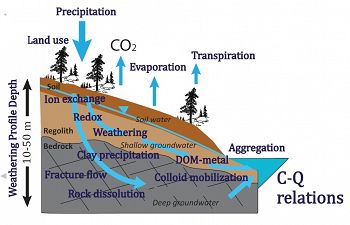Chorover et al., 2017
Concentration-Discharge Relations in the Critical Zone: Implications for Resolving Critical Zone Structure, Function and Evolution
Chorover, J., Derry, L. A., McDowell, W. H. (2017)
Water Resources Research 53(11): 8654–8659 Cross-CZO National
-
Catalina-Jemez, INVESTIGATOR
-
National, Shale Hills, INVESTIGATOR, COLLABORATOR
-
Luquillo, INVESTIGATOR
Abstract
An array of coupled hydrologic and biogeochemical processes superimposed on a complex critical zone structure give rise to concentration-discharge relations observed in surface waters.
Critical zone science seeks to develop mechanistic theories that describe critical zone structure, function and long-term evolution. One postulate is that hydrogeochemical controls on critical zone evolution can be inferred from solute discharges measured down-gradient of reactive flow paths. These flow paths have variable lengths, interfacial compositions, and residence times, and their mixing is reflected in concentration-discharge (C-Q) relations. Motivation for this special section originates from a U.S. Critical Zone Observatories workshop that was held at the University of New Hampshire, July 20-22, 2015. The workshop focused on resolving mechanistic CZ controls over surface water chemical dynamics across the full range of lithogenic (e.g., non-hydrolyzing and hydrolyzing cations and oxyanions) and bioactive solutes (e.g., organic and inorganic forms of C, N, P, S), including dissolved and colloidal species that may co-occur for a given element. Papers submitted to this special section on “concentration-discharge relations in the critical zone” include those from authors who attended the workshop, as well as others who responded to the open solicitation. Submissions were invited that utilized information pertaining to internal, integrated catchment function (relations between hydrology, biogeochemistry and landscape structure) to help illuminate controls on observed C-Q relations.
Synopsis
This article introduces the special section of Water Resources Research entitled "Concentration-Discharge Relations in the Critical Zone"
Citation
Chorover, J., Derry, L. A., McDowell, W. H. (2017): Concentration-Discharge Relations in the Critical Zone: Implications for Resolving Critical Zone Structure, Function and Evolution. Water Resources Research 53(11): 8654–8659. DOI: 10.1002/2017WR021111
 This Paper/Book acknowledges NSF CZO grant support.
This Paper/Book acknowledges NSF CZO grant support.
Explore Further




